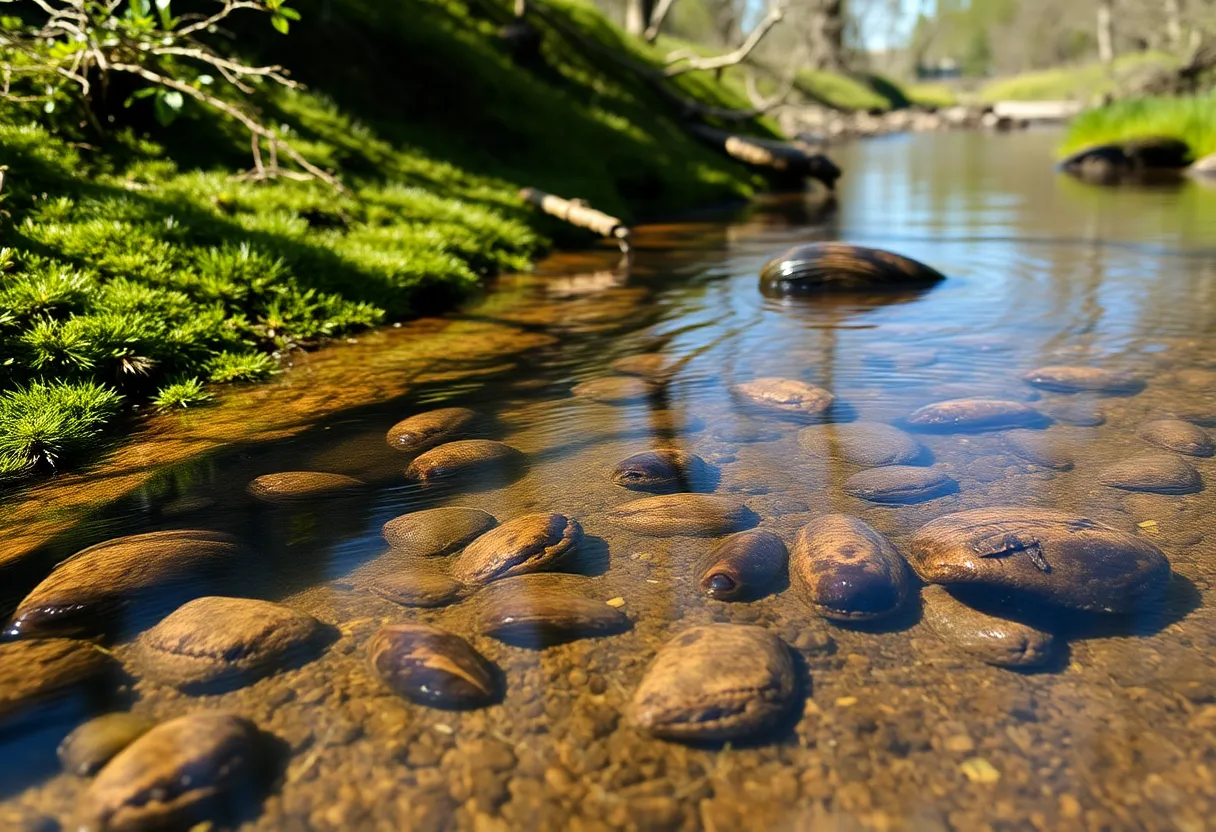News Summary
A recent survey in Plaster Creek, Kentwood, revealed over 500 freshwater mussels, including several rare and endangered species. Conducted by biologists from Grand Valley State University and Calvin University students, this finding highlights potential ecological recovery despite pollution concerns. The mussels play a crucial role in filtering water and maintaining ecosystem health, and their presence signifies hope for the creek’s ongoing restoration efforts.
Kentwood, Michigan – A recent survey has revealed the presence of several rare freshwater mussel species in Plaster Creek, one of West Michigan’s most polluted waterways. This discovery offers a glimmer of hope for the creek’s recovery as efforts to improve the area’s recreational and environmental conditions continue. The survey was conducted on July 16 by biologists from Grand Valley State University (GVSU), alongside over a dozen undergraduate students from Calvin University, under the initiative aimed at community awareness and ecological recovery.
During the survey, biologists uncovered more than 500 freshwater mussels, representing seven different species. Among the findings were two mussel species recognized by the state as endangered, in addition to one categorized as a species of special concern. The presence of these diverse mussels indicates a potential for ecological recovery despite Plaster Creek’s history of pollution from urban runoff and activities associated with the nearby airport.
Freshwater mussels play an essential ecological role, with each mussel capable of filtering between eight and 15 gallons of water per day. Their filtration capacity aids in maintaining water quality, thereby supporting overall ecosystem health. The importance of mussels is underscored by their longevity, with many living for 20 to 30 years and some surpassing 50 years. Unfortunately, many mussel species in the United States are endangered or threatened due to habitat loss and declining water quality.
Andrea Lubberts, the program manager for Plaster Creek Stewards, indicated that the variety of mussels found is a significant sign of hope for the creek’s future. The Plaster Creek Stewards initiative has been active for 15 years, focusing on raising community awareness and implementing cleanup efforts in the watershed area. Community involvement has proven crucial, as stakeholders like the Garst family stress the importance of local engagement for environmental improvements.
The watershed feeding into Plaster Creek has been significantly impacted by urbanization, contributing to water quality issues that are exacerbated by rapid rainwater runoff. This urban stream flows into the Grand River in downtown Grand Rapids, presenting unique challenges for environmental restoration. As part of ongoing restoration efforts, various stormwater management techniques, including the establishment of rain gardens, are being promoted to filter and cleanse water entering Plaster Creek.
Educational programs are also being developed for high school students and adults, emphasizing the value of native plants in constructing and maintaining rain gardens. Such initiatives not only foster an understanding of ecological systems but also encourage community involvement in the restoration process.
The recent discovery of freshwater mussels showcases that despite the challenges posed by pollution, some aspects of the Plaster Creek ecosystem still retain a certain level of ecological health. The existence of diverse mussel communities can signal the potential for recovery and improvement in water quality, highlighting the vital connections between community action, ecological restoration, and the health of natural water systems.
In conclusion, the significant number of rare mussel species found in Plaster Creek represents an encouraging development in the larger context of environmental recovery efforts in Kentwood. Continued collaboration among community members, biologists, and environmental organizations will be essential to ensure the ongoing health and sustainability of this important aquatic ecosystem.
Deeper Dive: News & Info About This Topic
HERE Resources
Additional Resources
- MLive: Livers of the River Found in Grand Rapids Area
- Wikipedia: Freshwater Mussels
- WoodTV: Mastodon Skeleton Found in Kent County
- Google Search: Kent County Mastodon Skeleton
- WoodTV: Search for Man in Lake Near Greenville
- Google Scholar: Grand Rapids Ecological Restoration
- WoodTV: NWS Confirms Another Tornado in Kent County
- Encyclopedia Britannica: Natural Disasters
- WoodTV: Boil Water Advisory Lifted in Wyoming
- Google News: Wyoming Boil Water Advisory

Author: STAFF HERE GRANDRAPIDS WRITER
The GRAND RAPIDS STAFF WRITER represents the experienced team at HEREGrandRapids.com, your go-to source for actionable local news and information in Grand Rapids, Kent County, and beyond. Specializing in "news you can use," we cover essential topics like product reviews for personal and business needs, local business directories, politics, real estate trends, neighborhood insights, and state news affecting the area—with deep expertise drawn from years of dedicated reporting and strong community input, including local press releases and business updates. We deliver top reporting on high-value events such as ArtPrize, Festival of the Arts, and World of Winter. Our coverage extends to key organizations like the Grand Rapids Chamber of Commerce and Grand Rapids Community Foundation, plus leading businesses in furniture, healthcare, and technology that power the local economy such as Steelcase, Spectrum Health, and Meijer. As part of the broader HERE network, including HEREDetroitMI.com, HERENorthville.com, HERENovi.com, and HEREPlymouth.com, we provide comprehensive, credible insights into Michigan's dynamic landscape.





